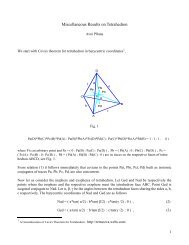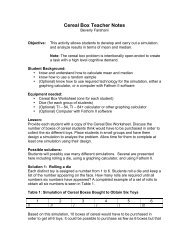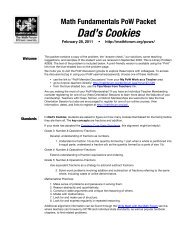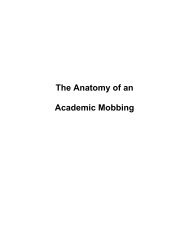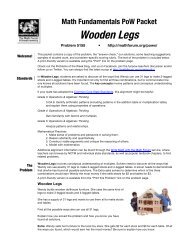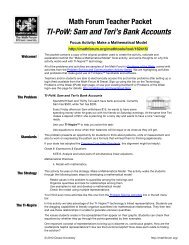Broken Pottery Teacher Packet - Math Forum
Broken Pottery Teacher Packet - Math Forum
Broken Pottery Teacher Packet - Math Forum
You also want an ePaper? Increase the reach of your titles
YUMPU automatically turns print PDFs into web optimized ePapers that Google loves.
Welcome! Welcome<br />
Standards<br />
The Problem<br />
Geometry PoW <strong>Packet</strong><br />
<strong>Broken</strong> <strong>Pottery</strong><br />
May 30, 2011 • http://mathforum.org/pows/<br />
This packet contains a copy of the problem, the “answer check,” our solutions, some teaching<br />
suggestions, and samples of the student work we received in April 2006. This is Library Problem<br />
#3687. The text of the problem is included below. A print-friendly version is available using the “Print”<br />
link on the problem page.<br />
We invite you to visit the PoW discussion groups to explore these topics with colleagues. To access<br />
the discussions [log in using your PoW username/password], choose one of these methods:<br />
• use the link to “PoW Member Discussions” from your My PoW Work as a <strong>Teacher</strong> area<br />
• go to geopow-teachers directly: http://mathforum.org/kb/forum.jspa?forumID=529<br />
Are you making the most of your PoW Membership? If you have an Individual <strong>Teacher</strong> Membership,<br />
consider registering for one of our (free) Orientation Sessions to learn more about the features of your<br />
membership. <strong>Teacher</strong>s with Class or School or District Memberships are welcome to take the free<br />
Orientation Session but also are encouraged to register for one of our online courses. View<br />
information, dates, and links to register at http://mathforum.org/pd/.<br />
In <strong>Broken</strong> <strong>Pottery</strong>, students develop a method to determine the diameter of a circular plate when<br />
given a “sherd” of that plate (a pottery remnant). Key concepts include segment relationships in<br />
circles.<br />
If your state has adopted the Common Core State Standards, this alignment might be helpful, as the<br />
problem is related to but not exactly hit upon by several different standards:<br />
High School: Geometry: Circles<br />
G-C.2. Identify and describe relationships among inscribed angles, radii, and chords. Include the<br />
relationship between central, inscribed, and circumscribed angles; inscribed angles on a<br />
diameter are right angles; the radius of a circle is perpendicular to the tangent where the radius<br />
intersects the circle.<br />
High School: Geometry: <strong>Math</strong>ematical Practices<br />
1. Make sense of problems and persevere in solving them.<br />
2. Reason abstractly and quantitatively.<br />
3. Construct viable arguments and critique the reasoning of others.<br />
4. Model with mathematics.<br />
5. Use appropriate tools strategically.<br />
6. Attend to precision.<br />
7. Look for and make use of structure.<br />
Additional alignment information can be found through the Write <strong>Math</strong> with the <strong>Math</strong> <strong>Forum</strong> service,<br />
where teachers can browse by NCTM and individual state standards, as well as popular textbook<br />
chapters, to find related problems.<br />
<strong>Broken</strong> <strong>Pottery</strong><br />
A “sherd” is part of a piece of pottery that one might dig up at an<br />
archaeological site where pottery-making people once lived. Archaeologists<br />
usually want to figure out how big the original piece of pottery was, as that can<br />
tell them something about who might have made the piece and when it was<br />
made.<br />
Using the sherd shown, devise a method for determining the diameter of the<br />
original plate.<br />
Extra: Can you come up with another method?
Answer Check<br />
Our Solutions<br />
After students submit their solution, they can choose to “check” their work by looking at the answer<br />
that we provide. Along with the answer itself (which never explains how to actually get the answer) we<br />
provide hints and tips for those whose answer doesn’t agree with ours, as well as for those whose<br />
answer does. You might use these as prompts in the classroom to help students who are stuck and<br />
also to encourage those who are correct to improve their explanation.<br />
There are a lot of ways to tackle this task. Most (but not all) involve chords and radii or even tangents.<br />
Think you’ve got a good method? Here are some things to think about:<br />
• Would your method enable you to find the diameter to at least the nearest quarter inch?<br />
• Would your method work on different sized “sherds”? (You can try this by drawing various arcs<br />
on a piece of paper, where you know the actual radius of the starting circle.)<br />
• Can you think of things that might make your method more or less accurate?<br />
• Did you try to come up with more than one method?<br />
Method 1: Solve a Simpler Problem (Chord Bisectors)<br />
When I first started looking at this problem, I felt really stuck. All I knew was that the problem was<br />
about circles. I didn’t know where the center was, what the radius was, anything. I decided to start by<br />
listing what I did know or could measure:<br />
• The length of the arc<br />
• The straight distance from one edge of the arc to the other (the longest chord in the circle)<br />
One way to make a problem simpler is to try to connect it to a problem I’ve solved before. I could think<br />
of a few things I already know about arcs, chords, and circles.<br />
• The perpendicular bisector of a chord goes through the center of the circle<br />
• The arc length is a certain percentage of the circumference of the circle, the same percentage<br />
as the arc angle is of 360º<br />
• Half of the chord, the perpendicular bisector of the chord, and the radius form a right triangle<br />
Now I had some ideas I could relate the problem to, but I was still finding it hard, so I asked myself,<br />
“What makes this problem hard?” The answer: I don’t know where the center of the circle is!<br />
So I thought about the fact that the perpendicular bisector of a chord goes through the center. I know<br />
one chord in the circle, so I can make a line that the center is on:<br />
B<br />
Now what’s hard is that I have a line the center is on, but I need another point. If I could make the<br />
problem easier, I’d find another sherd from the same circle. I could put them together and make<br />
another chord and draw a second perpendicular bisector. The intersection would be the center!<br />
Even though that’s wishful thinking, it’s actually useful! Why can’t I think of this sherd in two pieces?<br />
Then I could draw two lines, and the intersection would give me the center of the circle! I did it a few<br />
different ways to be sure the choice of chords didn’t change the answer.<br />
© 2011 Drexel University 2<br />
A<br />
C
Here is the summary of my method: Pick four points on the edge of the plate. Draw chords connecting<br />
two pairs of points. Construct perpendicular bisectors of each chord. The intersection of the<br />
perpendicular bisectors of the chords is at the center of the circle. Now that you know where the<br />
center is, measure along any of the perpendicular bisectors from the center to the edge of the sherd to<br />
find the radius. Of course, you need to double that to find the diameter.<br />
I noticed that since the sherd was not a perfect circle, where I put the chords could change where the<br />
center was slightly. Realistically, a pottery sherd won’t be a perfect circle either, so I would<br />
recommend that the archaeologists use multiple pairs of chords and find an approximate center.<br />
Method 2: Getting Unstuck (Pythagorean Theorem)<br />
This problem reminded me of problems I’ve done before in which you know the length of a chord and<br />
you draw its perpendicular bisector and use algebra and the Pythagorean theorem to find the length of<br />
the radius. I right away drew this picture and labeled variables:<br />
But I could measure all of those lengths and I don’t see how they relate to the radius or diameter.<br />
I decided to go back to the problem I had solved that this reminded me of. Here was the diagram from<br />
that problem:<br />
I needed to include the center in my diagram, even though I don’t know where it is. Maybe a rough<br />
sketch will help…<br />
© 2011 Drexel University 3<br />
a<br />
a<br />
c<br />
b
I can measure the two halves of the chord, so those are known quantities. But I have two unknown<br />
quantities and no other relationship between them. I’m stuck again!<br />
I asked myself, “What am I missing?” I read through my problem solving and realized that there were<br />
unlabeled lines in my diagram whose length I could measure (labeled a and b below).<br />
I can measure a and b and then I can use this relationship to write x in terms of r: x = r – a.<br />
Now I can use the Pythagorean theorem with x, r, and b.<br />
r 2 = x 2 + b 2<br />
r 2 = (r – a) 2 + b 2<br />
r 2 = r 2 – 2ar + a 2 + b 2<br />
2ar = a 2 + b 2<br />
a<br />
r =<br />
€<br />
2 + b 2<br />
2a<br />
a<br />
d =<br />
€<br />
2 + b 2<br />
a<br />
Voila! Now I have a formula for the archaeologists. Draw the longest chord you can in the circle.<br />
Measure the distance from its midpoint to the closest point on the circle (on its perpendicular bisector)<br />
and the farthest point (the end of the chord). Call the shorter measurement a and the longer b. Use<br />
d =<br />
a 2 + b 2<br />
a<br />
to find the length of the diameter, d.<br />
€<br />
Method 3: Using a Template (What the Archaeologists Do)<br />
I used a compass to construct circles with different radii. Then I printed out and cut out my sherd and<br />
lined it up with different circles until I found the best match:<br />
© 2011 Drexel University 4<br />
a<br />
b<br />
x<br />
r<br />
r<br />
x<br />
r<br />
r
Teaching<br />
Suggestions<br />
Archaeologists could have a template like this, the way my dad has one for rolling out different<br />
diameter piecrusts. In fact, that’s what gave me the idea for this strategy.<br />
If they didn’t have a template, they could just use a compass and keep adjusting the angle of the<br />
compass until the arc of the circle they drew best matched the sherd. Then they could measure the<br />
diameter of the circle they drew.<br />
Problems that come from real-life scenarios like this one have great possibilities, and they can be extra<br />
challenging. In this problem, for example, drawing and measuring are viable solutions because they<br />
are solutions archaeologists would use in the field. They’re accurate enough for archaeological<br />
purposes. Students might be used to trying to solve problems geometrically or with algebra and if<br />
they’re stuck, encourage them to think about what kinds of measurement and drawing tools actual<br />
archaeologists could use.<br />
I think “getting your hands dirty” is pretty important to solving this problem (no archaeological puns<br />
intended). Most of the students who gave us inaccurate methods seemed to be solving the problem in<br />
theoretically, saying things like, “measure from the center to the end of the sherd.” Printing out the<br />
paper, cutting out the sherd, and testing your method will make it a lot harder to blithely say, “just<br />
measure from the center.”<br />
Students who do use geometric or algebraic methods need to figure out how to apply them to this<br />
situation that has no numbers, no helpful diagram, etc. They need to figure out what geometry has to<br />
do with this situation. One really helpful strategy in this case is “Solve a Simpler Problem” in which you<br />
try to relate this situation to others you’re more familiar with, change the situation by mathematizing it<br />
(drawing extra lines and triangles, etc.) and ask yourself, “What makes this problem hard? How can I<br />
make it easier?”<br />
Check out the resources in our Solve a Simpler Problem strategy for more hints about how to help<br />
students get started. You’ll find everything linked from the Activity Series link in the left menu bar when<br />
you’re logged in.<br />
The Online Resources Page for this problem contains links to related problems in the Problem Library<br />
and to other web-based resources.<br />
If you would like one page to find all of the Current Problems as we add them throughout the 2010-11<br />
season, including a calendar, consider bookmarking this page (a link to the page is always available in<br />
the left menu when you’re logged in):<br />
http://mathforum.org/pow/support/<br />
© 2011 Drexel University 5
Sample<br />
Student<br />
Solutions<br />
focus on<br />
Strategy<br />
Samantha<br />
age 15<br />
Strategy<br />
Novice<br />
K C<br />
age 14<br />
Strategy<br />
Novice<br />
In the solutions below, I’ve provided the scores the students would have received in the Strategy<br />
category of our scoring rubric. My comments focus on what I feel is the area in which they need the<br />
most improvement.<br />
Novice Apprentice Practitioner Expert<br />
Has no ideas<br />
that will lead<br />
them toward a<br />
successful<br />
solution.<br />
Shows no<br />
evidence of their<br />
strategy.<br />
Drawing<br />
Uses a method that really<br />
relies on luck – their method<br />
need not be 100% accurate,<br />
since it’s a rough piece of<br />
pottery.<br />
Might be based on drawing a<br />
very rough picture without<br />
any real math idea.<br />
Picks a sound strategy—success<br />
achieved through skill, not luck.<br />
Could be a Practitioner even if they<br />
assume it’s a semicircle – that’s<br />
reflected in Interpretation.<br />
Must have some mathematical basis.<br />
Draw the rest of the plate on a peice of paper, using tools such as the<br />
ruler, protracter, ect..<br />
This would only work is the piece of pottery is suppose to make a circular<br />
plate. Here is how I find out its diameter: (you might want to draw down<br />
what i said to have a better understanding of it.)<br />
First, I looked at the plate piece as a 2D piece of a circular plate. i know<br />
by looking at the piece that the curved side is part of a the circumference<br />
of the whole plate. I connect the two end points of the circumference with<br />
a straight line.<br />
Then i measured the line and made a mid-point on it. Then mark the line<br />
#1.<br />
I made another line that cut though the mid-point and creates 90 degree<br />
angles between the two line i made. Then mark the line #2<br />
I will extend the second line to the circumference and also triple the length<br />
of the line on the other side of the mid-point.<br />
At one end of the first line I drew, I will draw another line towards the<br />
second line(not the circumference’s direction) but make sure the angle<br />
between this line and the first line is 60 degree.<br />
Do the same thing with the other end point from the first line.<br />
Now, you created a equilateral triangle!<br />
Find the mid-points of every side of the triangle and connect each one to<br />
the triangle’s corner directly across from it.<br />
Find the point where all three lines inside the triangle intercept. That’s<br />
also the center point of the whole plate.<br />
now, measure from the center point to the circumference and you will<br />
find the radius. Double that and you will find the diameter!<br />
Might talk<br />
about which<br />
strategies will<br />
do a better job,<br />
or how they’ll<br />
be more<br />
accurate if the<br />
piece is bigger.<br />
Samantha hasn’t told us<br />
enough about her drawing<br />
strategy to know if she will<br />
get an accurate sketch or<br />
not. I wonder how the<br />
protractor will help her with<br />
her drawing. I would ask her<br />
to tell me more about how<br />
she can guarantee an<br />
accurate drawing.<br />
K C has a lot of ideas but<br />
I’m not sure what the<br />
mathematical reasoning<br />
behind them is. I tried<br />
following K C’s method but<br />
the intersection point I<br />
created wasn’t the center of<br />
the circle. I can’t think of a<br />
method using an equilateral<br />
triangle so I would ask K C<br />
what this problem reminded<br />
them of and what they had<br />
noticed about the problem<br />
as they chose their strategy.<br />
Maybe K C had some other<br />
ideas they had thought of<br />
that we could build on.<br />
© 2011 Drexel University 6
Sean<br />
age 17<br />
Strategy<br />
Apprentice<br />
Nick<br />
age 14<br />
Strategy<br />
Apprentice<br />
Hayley<br />
age 15<br />
Strategy<br />
Practitioner<br />
James<br />
age 14<br />
Strategy<br />
Practitioner<br />
Using a geometrical method that includes a “Chord” instead of Diameters,<br />
to find the Diameter.<br />
Line Segment AB is a Chord, Consisting of Vertex A and B as shown in<br />
the Picture given. To find the Diameter, Take Chord AB, and duplicate it,<br />
but have it perpendicular to one of the points. Do the same procedure two<br />
times more. You will form a Square from the Chords. At that point, you<br />
can create and measure the Hypotenuse between the angles. The<br />
hypotenuse is the Diameter. Divide the Diameter in half to create the<br />
Radius, and then you can find your center point.<br />
My way to find the diameter is by measuring from the center to the<br />
outside of the plate and then multiply the measurement by 2.<br />
The way I got that is by taking what I knew about diameter. Which is that<br />
if you multiply the radius by 2 you get diameter. That is how I got my<br />
answer.<br />
You can trace the curve of the sherd, and move it around until you get a<br />
circle.<br />
If you place the sherd on a piece of paper you can use a pencil to trace<br />
the curve edge. Once you have traced the entire curved edge, simply<br />
adjust the curve so part of it is still lined up with the curve you’ve drawn,<br />
but now its position lets you trace more of the circle. This way, you are<br />
keeping the same curve, but can complete the circle. Continue tracing<br />
and adjusting the sherd until a full circle has been made. Then, measure<br />
the distance from one point on the circle’s edge to the point on the<br />
opposite edge to find the diameter.<br />
One way you can find the diameter of an old plate or something like it, is<br />
to have a compass and you trase around the plate for an aprroximate size<br />
First, you need a pencil, compass, paper, and the art work. You then<br />
place the art on the paper so you can trace around it. You then find a<br />
spot where the compass will follow the art all the way around. You then<br />
trace so that part of the plat or something is in the circle and fits the<br />
curve the compass made. You can then measure the diameter to find the<br />
approximate size of the art work.<br />
Sean’s strategy is valid for<br />
the case when the arc is 1/4<br />
of the circle. There are<br />
methods to calculate the arc<br />
angle and Sean could refine<br />
his method to account for<br />
different arc angles. I’m not<br />
sure what Sean knows<br />
about calculating arc angles,<br />
though, so I might just ask<br />
him, “What would happen if<br />
the sherd were 1/3 of the<br />
circle? Would your method<br />
still work? If not, how could<br />
you find the diameter for a<br />
sherd that’s an unknown<br />
fraction of the circle? ”<br />
Most of Nick’s strategy is<br />
perfect. The only trouble is,<br />
how does he know where<br />
the center of the circle is?<br />
That’s exactly what I would<br />
ask him, along with the<br />
question of what tools could<br />
he use (e.g. compass, ruler,<br />
etc.)<br />
Hayley’s tracing strategy is<br />
sound – this type of realworld<br />
problem is one where<br />
careful drawing is a great<br />
strategy. I would ask Hayley<br />
how accurate they think this<br />
method is, and what could<br />
affect that accuracy.<br />
James has done a nice job<br />
making use of an<br />
appropriate tool: the<br />
compass. I would ask<br />
James about accuracy as<br />
well.<br />
© 2011 Drexel University 7
Jayoung<br />
age 15<br />
Strategy<br />
Practitioner<br />
Tayshaun<br />
age 13<br />
Strategy<br />
Practitioner<br />
Paul<br />
age 17<br />
Strategy<br />
Practitioner<br />
There are a lot of ways to tackle this task. Most (but not all) involve chords<br />
and radii or even tangents.<br />
To figure out this problem, you need to assume that the plate/potter<br />
peice has been broken around or near the center. Thus from the edge of<br />
the break to the edge of the plate/pttery peice would be the radius so<br />
after that use the formula: (pi) r squared and u should get the answer<br />
instering whatever it is the radius would be.<br />
I used the Pythagorean theorem.<br />
I drew a chord across the sherd from the furthest points. Then I drew a<br />
perpendicular bisector of that chord. I know that bisector goes through<br />
the center of the circle because that is a theorem we learned. That means<br />
the center has to be on it somewhere.<br />
I drew the picture below. I made the whole chord c. The longest distance<br />
from the chord to the circle is x. The radius is r. The part between the<br />
chord and the center of the circle is r - x. I used the Pythagorean<br />
Theorem.<br />
(c/2)^2 + (r - x)^2 = r^2<br />
When you find the sherd, you can measure the chord and measure x, and<br />
then put them in the formula.<br />
The diameter of the original plate is 2 and 3/4 inches.<br />
First, I drew a circle with a compass. Then, I drew more circles around<br />
that circle. Then, I cut out the sherd from the problem page, and placed it<br />
on the paper with the circles and matched up the sherd to one of the<br />
circles. Then, I used the compass to draw the rest of the sherd, which<br />
was circular. I placed a ruler in a straight line from left to right across the<br />
dot made by the compass in the center of the pottery and got the<br />
diameter of 2 and 3/4 inches.<br />
Another way you could do this is to put the paper with the circles under<br />
the paper with the sherd, and shine a bright light on the top page. Then<br />
you can match up the sherd with one of the circles, draw the rest of the<br />
sherd, and use a ruler to get the diameter.<br />
Jayoung’s Intepretation of<br />
the problem has several<br />
errors: finding area rather<br />
than diameter, assuming the<br />
plate has to be broken near<br />
the center. But the strategy<br />
based on this interpretation<br />
is sound. I would ask<br />
Jayoung what they would<br />
do if the archaeologist found<br />
a small sherd that wasn’t<br />
broken near the center.<br />
Tayshaun has a sound<br />
strategy that would be pretty<br />
accurate if the<br />
measurements are accurate.<br />
He’s also explained his<br />
strategy pretty clearly and<br />
completely. I’d ask him to<br />
attempt the Extra by trying<br />
to find a second method…<br />
Maybe one that the<br />
archaeologists wouldn’t<br />
need a calculator to use?<br />
Paul used the same method<br />
archaeologists used! I’m not<br />
sure his second method is<br />
really mathematically<br />
different from his first, so I<br />
would give him the<br />
challenge to calculate the<br />
diameter without drawing a<br />
circle.<br />
© 2011 Drexel University 8
Becca<br />
age 17<br />
Strategy<br />
Practitioner<br />
Aman<br />
age 13<br />
Strategy<br />
Expert<br />
I would find the diameter by using perpendicular lines and the tangent<br />
points.<br />
First you would have to find the radius.<br />
You do this by:<br />
1. Draw two lines that are perpendicular to each other against the outside<br />
of the sherd.<br />
2. Find the tangent point of each line where it touches the plate.<br />
3. From the tangent point draw a line perpendicular to it. (Do this to both<br />
tangent points)<br />
4. Where the two new lines meet is where the middle of the plate should<br />
be. This would be the radius.<br />
5. Once you have the radius then you can find the diameter by doubleing<br />
the radius.<br />
1. The method is simply to construct a tangent line to the inner circle with<br />
endpoints on the circumference of the outer circle. This creates a right<br />
triangle after which you can use the Pythagorean Theorem. EXTRA:<br />
Another method is to use the c<br />
Before the plate was broken, it obviously consisted of two concentric<br />
circles (two circles, where the distance between their circumferences are<br />
constant around the circumference). Let their center be C, although you<br />
cannot see the center. Now, draw two points on the circumference of the<br />
outer circle, A and B, where the line AB is tangent to the inner circle at<br />
point D. So now, you have what looks like a line beginning and ending on<br />
the circumference of the outer circle and touching the inner circle. Next,<br />
draw ray CD and let the intersection of this ray and the outer circle be at<br />
point E. The distance DE is therefore, the distance between the two<br />
circles. Observe how the triangle DA AC CD is a right triangle. DA is a<br />
constant since you can measure it and let's use x to represent it. AC is<br />
the radius of the outer circle and CD is the radius of the inner circle. So,<br />
AC = CD + DE. DE is a measurable constant as well and let's use y to<br />
represent it. let r = CD. So AC = y + r. According to the Pythagorean<br />
Theorem,<br />
DA^2 + CD^2 = AC^2<br />
x^2 + r^2 = (y + r)^2<br />
x^2 + r^2 = y^2 + 2yr + r^2<br />
x^2 = y^2 + 2yr<br />
x^2 - y^2 = 2yr<br />
(x^2 - y^2)/2y = r<br />
As AC was the original radius, I'm not done yet.<br />
AC = y + r<br />
AC = y + (x^2 - y^2)/2y<br />
AC = 2y^2/2y + (x^2 - y^2)/2y<br />
AC = (x^2 + y^2)/2y<br />
2AC = (x^2 + y^2)/y<br />
That is the diameter. Just substitute values, which you have to measure<br />
for x and y.<br />
Becca used tangent lines to<br />
find the center of the circle,<br />
another sound strategy. I’m<br />
not convinced that the lines<br />
have to be perpendicular to<br />
each other (her step 1) and<br />
wonder if she meant two<br />
lines that are perpendicular<br />
to the radii of the sherd?<br />
Aman generated two pretty<br />
different methods, using<br />
known measurements to<br />
find unknown ones. His<br />
explanation was clear and<br />
complete as well. Both<br />
methods relied on the inner<br />
and outer circles of the<br />
sherd. I’d ask Aman if he<br />
would take on the challenge<br />
of what to do if the sherd<br />
didn’t have an obvious inner<br />
circle.<br />
© 2011 Drexel University 9
Scoring Rubric<br />
EXTRA: First, let me define all of my variables. let a = angle(the central<br />
angle at which the plate was broken) let x = radius of the smaller circle let<br />
y = distance between the two circumferences of the two circles let c = arc<br />
of inner circle that is showing let d = arc of outer circle that is showing So,<br />
with my variables I can set up a simple circumference equation in terms<br />
of the central angle and the radius. Similarly, for the outer circle, the<br />
radius will be the radius of the inner circle plus y. So,<br />
(a/360)(2xpi) = c<br />
(a/360)(2xpi + 2ypi) = d<br />
After simplifying and solving for a, I get<br />
a = (180d - 180c)/ypi<br />
After substituting this into the former equation and simplifying, I arrive at<br />
x = cy/(d - c)<br />
Of course, c, d, and y and constants that can be measured.<br />
A problem-specific rubric can be found linked from the problem to help in assessing student<br />
solutions. We consider each category separately when evaluating the students’ work, thereby<br />
providing more focused information regarding the strengths and weaknesses in the work. A generic<br />
student-friendly rubric can be downloaded from the Teaching with PoWs link in the left menu (when<br />
you are logged in). We encourage you to share it with your students to help them understand our<br />
criteria for good problem solving and communication.<br />
We hope these packets are useful in helping you make the most of Geometry Problems of the Week.<br />
Please let me know if you have ideas for making them more useful.<br />
~ Max and Annie<br />
© 2011 Drexel University 10



